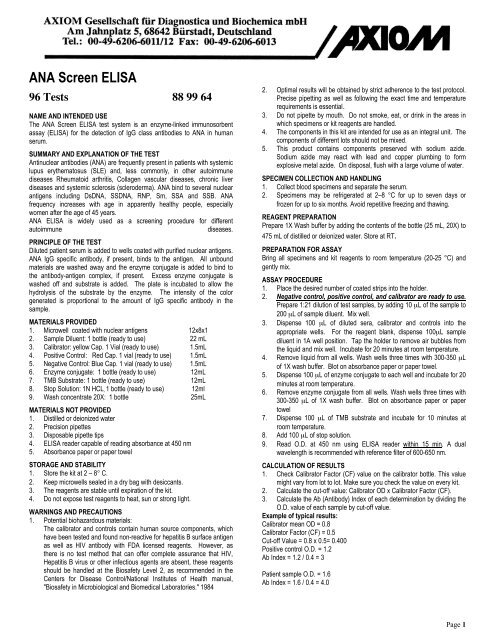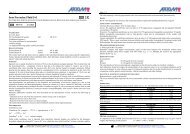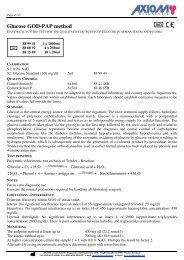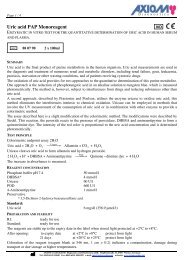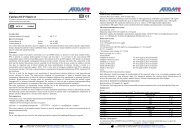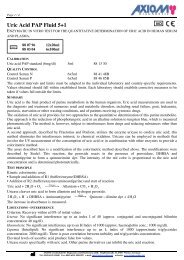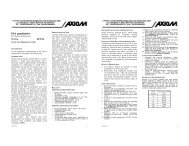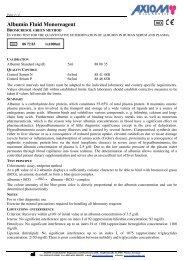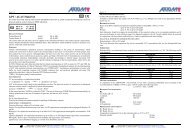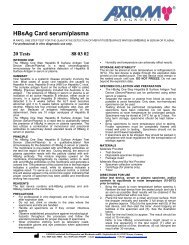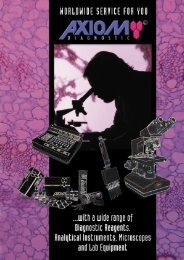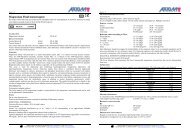ANA Screen ELISA - AXIOM Solutions
ANA Screen ELISA - AXIOM Solutions
ANA Screen ELISA - AXIOM Solutions
Create successful ePaper yourself
Turn your PDF publications into a flip-book with our unique Google optimized e-Paper software.
<strong>ANA</strong> <strong>Screen</strong> <strong>ELISA</strong><br />
96 Tests 88 99 64<br />
NAME AND INTENDED USE<br />
The <strong>ANA</strong> <strong>Screen</strong> <strong>ELISA</strong> test system is an enzyme-linked immunosorbent<br />
assay (<strong>ELISA</strong>) for the detection of IgG class antibodies to <strong>ANA</strong> in human<br />
serum.<br />
SUMMARY AND EXPL<strong>ANA</strong>TION OF THE TEST<br />
Antinuclear antibodies (<strong>ANA</strong>) are frequently present in patients with systemic<br />
lupus erythematosus (SLE) and, less commonly, in other autoimmune<br />
diseases Rheumatoid arthritis, Collagen vascular diseases, chronic liver<br />
diseases and systemic sclerosis (scleroderma). <strong>ANA</strong> bind to several nuclear<br />
antigens including DsDNA, SSDNA, RNP, Sm, SSA and SSB. <strong>ANA</strong><br />
frequency increases with age in apparently healthy people, especially<br />
women after the age of 45 years.<br />
<strong>ANA</strong> <strong>ELISA</strong> is widely used as a screening procedure for different<br />
autoimmune<br />
diseases.<br />
PRINCIPLE OF THE TEST<br />
Diluted patient serum is added to wells coated with purified nuclear antigens.<br />
<strong>ANA</strong> IgG specific antibody, if present, binds to the antigen. All unbound<br />
materials are washed away and the enzyme conjugate is added to bind to<br />
the antibody-antigen complex, if present. Excess enzyme conjugate is<br />
washed off and substrate is added. The plate is incubated to allow the<br />
hydrolysis of the substrate by the enzyme. The intensity of the color<br />
generated is proportional to the amount of IgG specific antibody in the<br />
sample.<br />
MATERIALS PROVIDED<br />
1. Microwell coated with nuclear antigens 12x8x1<br />
2. Sample Diluent: 1 bottle (ready to use) 22 mL<br />
3. Calibrator: yellow Cap. 1 Vial (ready to use) 1.5mL<br />
4. Positive Control: Red Cap. 1 vial (ready to use) 1.5mL<br />
5. Negative Control: Blue Cap. 1 vial (ready to use) 1.5mL<br />
6. Enzyme conjugate: 1 bottle (ready to use) 12mL<br />
7. TMB Substrate: 1 bottle (ready to use) 12mL<br />
8. Stop Solution: 1N HCL, 1 bottle (ready to use) 12ml<br />
9. Wash concentrate 20X: 1 bottle 25mL<br />
MATERIALS NOT PROVIDED<br />
1. Distilled or deionized water<br />
2. Precision pipettes<br />
3. Disposable pipette tips<br />
4. <strong>ELISA</strong> reader capable of reading absorbance at 450 nm<br />
5. Absorbance paper or paper towel<br />
STORAGE AND STABILITY<br />
1. Store the kit at 2 – 8° C.<br />
2. Keep microwells sealed in a dry bag with desiccants.<br />
3. The reagents are stable until expiration of the kit.<br />
4. Do not expose test reagents to heat, sun or strong light.<br />
WARNINGS AND PRECAUTIONS<br />
1. Potential biohazardous materials:<br />
The calibrator and controls contain human source components, which<br />
have been tested and found non-reactive for hepatitis B surface antigen<br />
as well as HIV antibody with FDA licensed reagents. However, as<br />
there is no test method that can offer complete assurance that HIV,<br />
Hepatitis B virus or other infectious agents are absent, these reagents<br />
should be handled at the Biosafety Level 2, as recommended in the<br />
Centers for Disease Control/National Institutes of Health manual,<br />
"Biosafety in Microbiological and Biomedical Laboratories." 1984<br />
2. Optimal results will be obtained by strict adherence to the test protocol.<br />
Precise pipetting as well as following the exact time and temperature<br />
requirements is essential.<br />
3. Do not pipette by mouth. Do not smoke, eat, or drink in the areas in<br />
which specimens or kit reagents are handled.<br />
4. The components in this kit are intended for use as an integral unit. The<br />
components of different lots should not be mixed.<br />
5. This product contains components preserved with sodium azide.<br />
Sodium azide may react with lead and copper plumbing to form<br />
explosive metal azide. On disposal, flush with a large volume of water.<br />
SPECIMEN COLLECTION AND HANDLING<br />
1. Collect blood specimens and separate the serum.<br />
2. Specimens may be refrigerated at 2–8 °C for up to seven days or<br />
frozen for up to six months. Avoid repetitive freezing and thawing.<br />
REAGENT PREPARATION<br />
Prepare 1X Wash buffer by adding the contents of the bottle (25 mL, 20X) to<br />
475 mL of distilled or deionized water. Store at RT.<br />
PREPARATION FOR ASSAY<br />
Bring all specimens and kit reagents to room temperature (20-25 °C) and<br />
gently mix.<br />
ASSAY PROCEDURE<br />
1. Place the desired number of coated strips into the holder.<br />
2. Negative control, positive control, and calibrator are ready to use.<br />
Prepare 1:21 dilution of test samples, by adding 10 µL of the sample to<br />
200 µL of sample diluent. Mix well.<br />
3. Dispense 100 µL of diluted sera, calibrator and controls into the<br />
appropriate wells. For the reagent blank, dispense 100µL sample<br />
diluent in 1A well position. Tap the holder to remove air bubbles from<br />
the liquid and mix well. Incubate for 20 minutes at room temperature.<br />
4. Remove liquid from all wells. Wash wells three times with 300-350 µL<br />
of 1X wash buffer. Blot on absorbance paper or paper towel.<br />
5. Dispense 100 µL of enzyme conjugate to each well and incubate for 20<br />
minutes at room temperature.<br />
6. Remove enzyme conjugate from all wells. Wash wells three times with<br />
300-350 µL of 1X wash buffer. Blot on absorbance paper or paper<br />
towel<br />
7. Dispense 100 µL of TMB substrate and incubate for 10 minutes at<br />
room temperature.<br />
8. Add 100 µL of stop solution.<br />
9. Read O.D. at 450 nm using <strong>ELISA</strong> reader within 15 min. A dual<br />
wavelength is recommended with reference filter of 600-650 nm.<br />
CALCULATION OF RESULTS<br />
1. Check Calibrator Factor (CF) value on the calibrator bottle. This value<br />
might vary from lot to lot. Make sure you check the value on every kit.<br />
2. Calculate the cut-off value: Calibrator OD x Calibrator Factor (CF).<br />
3. Calculate the Ab (Antibody) Index of each determination by dividing the<br />
O.D. value of each sample by cut-off value.<br />
Example of typical results:<br />
Calibrator mean OD = 0.8<br />
Calibrator Factor (CF) = 0.5<br />
Cut-off Value = 0.8 x 0.5= 0.400<br />
Positive control O.D. = 1.2<br />
Ab Index = 1.2 / 0.4 = 3<br />
Patient sample O.D. = 1.6<br />
Ab Index = 1.6 / 0.4 = 4.0<br />
Page 1
QUALITY CONTROL<br />
The test run may be considered valid provided the following criteria are met:<br />
1. If the O.D. of the Calibrator should be greater than 0.250.<br />
2. The Ab index for Negative control should be less than 0.9.<br />
3. The Ab index for Positive control should be greater than 1.2.<br />
INTERPRETATION<br />
The following is intended as a guide to interpretation of <strong>ANA</strong> IgG test results;<br />
each laboratory is encouraged to establish its own criteria for test<br />
interpretation based on sample populations encountered.<br />
Antibody Index Interpretation<br />
1.1 Detectable <strong>ANA</strong> IgG by <strong>ELISA</strong>.<br />
LIMITATIONS OF THE TEST<br />
1. The test results obtained using this kit serve only as an aid to<br />
diagnosis and should be interpreted in relation to the patient’s<br />
history, physical findings and other diagnostic procedures.<br />
2. Lipemic or hemolyzed samples may cause erroneous results.<br />
REFERENCES<br />
1. Emlen W; O'Neill L Clinical significance of antinuclear antibodies: comparison of<br />
detection with immunofluorescence and enzyme-linked immunosorbent assays.<br />
Arthritis Rheum 1997;40(9):1612-8.<br />
2. Gonz´alez C; Martin T; Arroyo T; Garc´ia-Isidoro M; Navajo JA; Gonz´alez-<br />
Buitrago JM. Comparison and variation of different methodologies for the<br />
detection of autoantibodies to nuclear antigens (<strong>ANA</strong>). J Clin Lab Anal<br />
1997;11(6):388-92.<br />
3. Parveen S; Morshed SA; Nishioka M. High prevalence of antibodies to<br />
recombinant CENP-B in primary biliary cirrhosis: nuclear immunofluorescence<br />
patterns and <strong>ELISA</strong> reactivities. J Gastroenterol Hepatol 1995;10(4):438-45.<br />
4. Welin Henriksson E; Hansson H; Karlsson-Parra A; Pettersson I. Autoantibody<br />
profiles in canine <strong>ANA</strong>-positive sera investigated by immunoblot and <strong>ELISA</strong>. Vet<br />
Immunol Immunopathol 1998;61(2-4):157-70.<br />
5. Koh WH; Dunphy J; Whyte J; Dixey J; McHugh NJ. Characterisation of<br />
anticytoplasmic antibodies and their clinical associations [see comments]. Ann<br />
Rheum Dis 1995;54(4):269-73.<br />
6. Spronk PE; Bootsma H; Horst G; Huitema MG; Limburg PC; Cohen Tervaert<br />
JW; Kallenberg CG. Antineutrophil cytoplasmic antibodies in systemic lupus<br />
erythematosus. Br J Rheumatol 1996;35(7):625-31.<br />
PERFORMANCE CHARACTERISTICS<br />
1. Sensitivity and Specificity<br />
354 patient sera were tested by this <strong>ELISA</strong> and a reference <strong>ELISA</strong> methods.<br />
148 sera were positive and 188 sera were negative by both methods. The<br />
agreement between the two methods was 95% (336/354).<br />
The results are summarized below:<br />
<strong>ANA</strong> IgG <strong>ELISA</strong><br />
+ + ! Total<br />
Reference <strong>ELISA</strong> + 148 6 4 158<br />
Kit + 2 0 0 2<br />
_ 6 0 188 194<br />
Total 156 6 214 354<br />
2.. Precision<br />
Intra-Assay Study<br />
Serum No. of<br />
Replicates<br />
Mean<br />
1 16 1.41<br />
2 16 0.82<br />
3 16 0.29<br />
Standard<br />
Deviation<br />
0.06<br />
0.02<br />
0.03<br />
Coefficient of<br />
Variation %<br />
4.22<br />
2.6<br />
9.48<br />
Serum<br />
1<br />
2<br />
3<br />
Inter-Assay Study<br />
No. of Mean<br />
Replicates<br />
10 1.15<br />
10 0.81<br />
10 0.29<br />
Standard<br />
Deviation<br />
0.09<br />
0.1<br />
0.03<br />
Coefficient of<br />
Variation %<br />
7.43<br />
11.8<br />
9.48<br />
Page 2


